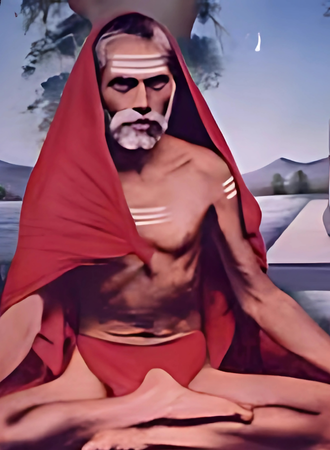Sant Tembe Swami
Vasudevanand Saraswati (1854–1914), also known as Tembe Swami, was a revered Hindu saint and is widely regarded as an incarnation of Lord Dattatreya. He holds a significant place in the Dattatreya tradition and is honored for his spiritual teachings and divine life.
Name – Sant Tembe Swami
Born – Vasudev Ganesh Tembe 13 August 1854 Mangaon, Sindhudurg, Maharashtra, India
Died – 24 June 1914 Garudeshwar, Narmada, Gujarat, India.
Religion – Hinduism
Sect – Datta Sampradaya
Tembe Swami (Vasudevanand Saraswati), born in 1854 in Mangaon, Maharashtra, was a revered saint and believed to be an incarnation of Lord Dattatreya. His parents were devoted followers of Dattatreya, with his father, Ganesh Bhatt Tembe, receiving a divine vision promising the Lord’s birth as his son.
From a young age, Vasudev showed exceptional intellect, mastering Sanskrit grammar and scriptures. He married Annapurnabai in 1875 and later established the Datta Mandir at Mangaon in 1883, where the idol was divinely ordained.
A strict follower of the Sanyas Ashram discipline, Tembe Swami travelled India for 23 years, offering guidance and blessings without caste discrimination. He authored over 19 spiritual texts, including Dwisahastri Gurucharitra, Datta Puran, and Saptashati Gurucharitra Saar—a simplified version of the GuruCharitra for women.
After his wife’s death in 1891, he embraced sanyas on the banks of the Godavari and was formally initiated by Narayanand Saraswati at Ujjaini.
Gajanan Maharaj, Shegaon – In 1905, during his visit to Shegaon, Tembe Swami Maharaj met the revered Shri Gajanan Maharaj. A day before, Gajanan Maharaj had foretold his arrival, referring to him as a “learned Karhade Brahmin and strict puritan,” advising devotees to maintain cleanliness in his path.
When Swami Maharaj arrived, the two saints exchanged a deep, silent connection—no words, just mutual reverence. After the brief encounter, Swami Maharaj departed, and Gajanan Maharaj simply remarked, “Very nice!”
When devotees questioned how two saints with such different lifestyles could be brothers, Gajanan Maharaj explained that their differences were external; spiritually, both were united in the universal consciousness, beyond all form and identity.
Swami Samarth, Akkalkot – Swami Samarth of Akkalkot, revered as an incarnation of Lord Dattatreya, once spiritually connected with Tembe Swami Maharaj in 1905. While traveling from Narsobawadi to Pandharpur, Swami Maharaj had a dream in Kamalapur, where a tall divine figure with long arms appeared and asked, “You travel and compose verses—why neglect me?”
Upon waking, Maharaj asked the Lord about the vision. The divine reply was: “He is Swami Samarth of Akkalkot. Visit Akkalkot and write his life in verse.” Swami Maharaj humbly responded that his speech was dedicated to Dattatreya, but if commanded and given the knowledge, he would compose the work. He then received divine instruction to stop at Akkalkot on his journey to Pandharpur.
Sai Baba, Shirdi – Sai Baba of Shirdi, revered as an incarnation of Lord Dattatreya, was a contemporary of Swami Vasudevanand Saraswati (Tembe Swami Maharaj). A devoted follower of Sai Baba, Pundalika Rao from Nanded, visited Swami Maharaj in Rajamahendri, Andhra Pradesh. After performing a devotional keertan, Swami Maharaj gave him a coconut, saying, “Give this to my brother,” referring to Sai Baba.
On the way to Shirdi, the group halted at Kopargaon, where, due to heat and thirst, the devotees unknowingly consumed the very coconut Swami Maharaj had sent for Sai Baba. Upon reaching Shirdi, Sai Baba unusually greeted them with anger, calling them “thieves and scoundrels”, asking, “Where is the coconut my brother gave me?” Once the group admitted the mistake, Sai Baba forgave them but strongly emphasized the spiritual significance of the offering.
Swami Vasudevanand Saraswati Maharaj’s Mahasamadhi occurred on Ashadh Shuddha Pratipada, a Tuesday under Ardra Nakshatra. Though originally set to depart on Jyeshtha Amavasya, he delayed it through deep Samadhi, saying, “Today’s scheduled departure has been avoided.”
On Amavasya, in severe pain, he called Appa Shastri Jere and confided past black magic troubles without resentment. Attempting his daily rituals one last time, he surrendered to divine will. As Amavasya ended, he sat facing west, performed Tratak, controlled his breath, and left his body with a powerful “Om.”
His body was immersed in the Narmada River, and his Samadhi now rests at Garudeshwar, Gujarat, beside the sacred Datta Mandir—a revered pilgrimage site for devotees of Lord Dattatreya.
Mangaon – Mangaon is the sacred birthplace of Swami Vasudevanand Saraswati (Tembe Swami Maharaj). After his stay at Narsobawadi, he returned here for 7 years as per Lord Dattatreya’s command. During this time, Maharaj personally built the Datta Mandir, laying each brick by hand. The idol was crafted by a sculptor from Kagal, following divine instructions received in a dream.
Though Maharaj took the original idol with him, the Mangaon Datta Mandir still stands and is maintained by the Datta Mandir Mangaon Trust. In 1961, the temple was beautifully renovated by Queen Indira Holkar of Indore, a devoted follower. The premises include Bhakta Nivas (devotee accommodation) and offer Mahaprasad meals at a nominal cost.
His Janmasthan (birthplace) has been preserved with an idol of Maharaj in a standing pose, and the adjacent Yakshini temple remains an integral part of this holy site.
Narsobawadi – Swami Vasudevanand Saraswati Maharaj resided in Narsobawadi for 12 years, a sacred place known for being the seat of Lord Narasimha Saraswati, the second Purna (complete) incarnation of Lord Dattatreya. The room where Maharaj stayed is located near the revered Datta Mandir, which houses the divine Padukas (footprints) of Dattatreya.

